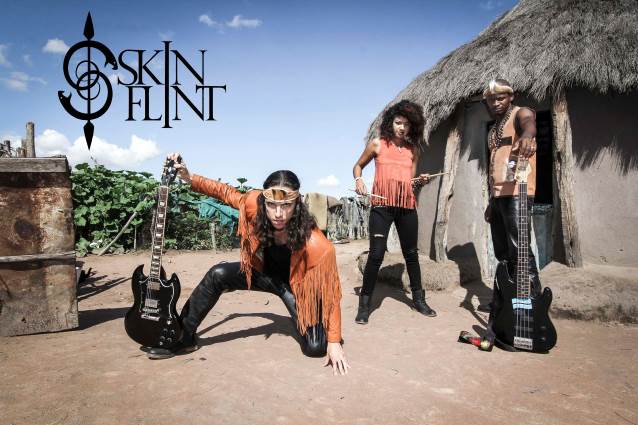With a mix of South African influence and mythology incorporating indigenous elements into their costumed metal sound, Botswana trio Skinflint bring their new self-titled effort to the worlds ears. During their 11 year existence they’ve earned respect and recognition as one of the most prominent metal bands in their scene garnering attention from the BBC, CNN and African Music websites.
Skinflint is guitarist, vocalist Giuseppe and drummer Alessandra Sbrana with bassist Kebonye Nkoloso. Hailing from Gaborone, Botswana South Africa, they formed in 2006, forging and fusing their sound in ceremonial fire, incorporating native lore into narrative lyrics surrounding their stories with traditional thrash metal riffs and ethos. Proof that metal can come from anywhere, they’re dedicated to putting themselves and Botswana on the metal map. They could become the Sepultura of their scene.
This year’s Skinflint album marks their fifth full length along with their original Guana EP. They’ve created classic thrash tunes weaving stories about South African history, folklore and mythology. Stories about ancient spirits, animalistic energies, nightmarish creatures and brave warriors dance through the lyrics like war-painted initiates around a tribal fire.
They’ve toured all through their homeland and Europe, sharing stages with Tarja Turunen in March 2017, dubbed The Shadow Shows bringing them to audiences that had never experienced African metal. “I found in each location the fans responded differently,” Alessandra says. “In Holland a lot of the guys were observant in the beginning. After a couple songs they started to understand the music. In Switzerland and Germany we had a really, energetic response. They were really surprised and excited about the sound we had.” During the run they had limited interaction with Turunen but did talk and eat with her band. Their dream gig/tour would be to play with Metallica and Iron Maiden.
Giuseppe adds, “The response has been curiosity,” he says. “Most people after a few songs are curious. I think most people haven’t seen a heavy metal band from Botswana before so they’re curious about our style. Towards the middle and end of the set they started warming up to us. The feedback was actually fantastic.”
Their new video is a conceptual piece for “Birds and Milk, Bloody Milk,” “The head that comes out of the bowl is a cow’s head,” he explains. “It’s inspired by an African tale. This bird is in the tree and this guy’s having hallucinations like the birds speaking to him and tells him to kill the cow. In return it will bring him 100 more cows. So the man in desperate condition complies but obviously the bird doesn’t keep its end of the agreement.” They decided to use milk instead of blood in the video to make it look more symbolic. “You can see the cows head coming out of the milk signifying the cow was killed and the milk can be the bloody milk.”
The video features a group of dancers doing a popular dance called Kwassa kwassa, “It’s a popular style of music in Botswana, eastern Africa, and we wanted to incorporate that with heavy metal which hasn’t been done before,” he says. The experience was a first for everyone.
Their ‘Ram of Fire” video from the Chief of the Ghosts album is a unique visual experience filmed around a fire. “It’s more of a tribal dance,” Alessandra says. “It’s mostly about doing particular rituals to start rain,” Giuseppe says. Due to budget limitations their full vision couldn’t be put on screen though the end product’s still captivating.
The song “Chiruwi” from Skinflint is about a half-man creature in African mythology. Other songs from their library speak of water spirits, large bats and other campfire tales ranging from boogie man stories to documented West African cannibals (“Abiku” from Nyemba). “Anyoto Aniota” from Chief of the Ghosts is about warriors cloaking themselves in leopard skin to imitate them, like Tarzan. “Okove” from Nyemba is about a pendant said to have magical transforming powers, depending on its use and the users intended purpose.
Giuseppe explains the attraction to mythology, “I think story telling has drawn us to African culture. Growing up here, you’d always hear stories and mysterious. We wanted to incorporate storytelling into the music.”
Alessandra adds, “Most of it’s actually oral tradition and not based in fact. Most is just myth.” Though many tales have been documented by mainstream media. “We wanted to bring it to the forefront and inspire people to research the tales,” she says. The stories and tales have been used in other forms besides music. Giuseppe would love to see an RPG video game incorporating these myths.
 Both CNN and the BBC have covered the band, “Both times CNN flew to Botswana and did a feature on us,” Alessandra says. They were interviewed and went to their studio. The BBC followed suit, attending a show to fully understand the Botswana metal scene and get a sense of the fans and the entire movement. “I think they also came because Botswana has one of the most distinct metal scenes in the world.” The attire of choice being leather, cowboy hats, chains and horns also draws attention.
Both CNN and the BBC have covered the band, “Both times CNN flew to Botswana and did a feature on us,” Alessandra says. They were interviewed and went to their studio. The BBC followed suit, attending a show to fully understand the Botswana metal scene and get a sense of the fans and the entire movement. “I think they also came because Botswana has one of the most distinct metal scenes in the world.” The attire of choice being leather, cowboy hats, chains and horns also draws attention.
They’re well-known in their area with an uprising of up and coming talent around them, though, location brings more of a challenge with releasing music and advertising. The scene is loyal though still very underground. “Most DJ’s and radio here don’t know much about the metal scene, but it has a very strong underground following,” Giuseppe says. “The fans are very expressive. There’s quite a lot of metal fans in Botswana considering our population. We’re very proud of our scene.”
Commercial music dominates the airwaves with pop, electro, house music, R&B and hip hop without much love for alternative, rock or metal.
There are limited venues that will promote metal shows, so every show has a certain built in excitement. It’s very DIY, “The bands have to set up everything themselves,” Giuseppe says. “Most have to play in difficult situations but we still manage. We make it work.” They say mosh pits happen in South Africa as well but not crowd surfing so much.
Cell phones in the crowd are there too, especially the guys up front with fans climbing on stage ‘surprising the band.’ “They get on stage and grab your mic. So, you’re the new vocalist? Let’s play,” Giuseppe laughs. There’s security at shows but the free spirit, anything can happen vibe gives them a more, free feeling experience that fans can just go and have fun. “We know a lot of the guys, because it’s such a small community. So, it’s as much fun for us as it is them,” Alessandra says. “It’s unpredictable.”
Compared to the treatment of stage scramblers at other shows around the world, the metal scene there is very raw, with lots of energy. “It’s very different to where everything’s controlled,” Giuseppe says. “I can’t describe it, you just have to come and see it.” “You’ll find things you’ll only see here.”
Metal has been in Africa around 20 years from classic rock to psychedelic to ‘90s style. They mention ‘70s Zambian band Witch as an early pioneer of the movement.
They’re grateful for any and all coverage, “We’re really lucky to have had such recognition sometimes,” Alessandra says. “It doesn’t feel real that so many people are aware of our band.” It helps make a big impact, for them and other African metal bands, putting everyone on the map.
Alessandra says Metal4africa.com is a site that covers the whole continent. Advertising music from Africa, Kenya and other areas.
They give props to fellow metal mates Wrust as a great Botswana band and a band they’d take on tour. Also recommending Overthrust from Ghanzi.
 They’re influenced by what they grew up listening to. “For this latest album we just went a completely different direction,” Alessandra says. “Trying to stay as true to Skinflint as possible.” After over 11 years playing together they’ve discovered elements and nuances to their sound original and unique to them. “This latest album we wanted to pursue the elements that make the Skinflint sound stand out,” Giuseppe says.
They’re influenced by what they grew up listening to. “For this latest album we just went a completely different direction,” Alessandra says. “Trying to stay as true to Skinflint as possible.” After over 11 years playing together they’ve discovered elements and nuances to their sound original and unique to them. “This latest album we wanted to pursue the elements that make the Skinflint sound stand out,” Giuseppe says.
They have fans worldwide and their popularity is rising in the states, “We’ve had a lot of coverage from this album in the states. Magazines, websites and radio stations have interviewed us. By the end of the year we’ll have a better ability to see how this album has done in the states,” Alessandra says.
They’ve never been to America before as visitors or musicians, “We have no idea what to expect and we’re very excited about it,” Alessandra says. “I would love to go to New York and Arizona. Like the two extremes, the big city and the dessert.” Giuseppe has sights set on Los Angeles.
For those wanting to venture to Botswana, they recommend going to Kasane. “It’s a good place for tourists, the landscape is beautiful, Alessandra says. “It’s a nature reserve where you can see elephants, hippo’s and all the animals drink water. They’re used to people.” You can get up close to them for a real experience in the wild but not too close.
Their main focus is promoting the new record on any and all social media and digital platforms. They also have more videos coming with wait and see surprises on songs and concepts. Though they haven’t done any live shoots yet. They’d love to do videos for “Eyes In A Leopards Spots” or “Tokoloshe.”
Alessandra believes music makes us immortal, “We’re here for a purpose. Once we achieve that purpose, then that’s it. Almost like an eternal version of yourself. That’s what music is.” Giuseppe ends saying, “I think music is immortality to me. Whatever art you do. You believe in what you leave behind.”
They give a very big thank you to all the bands that supported them locally and internationally. “Keep the fire burning.”





